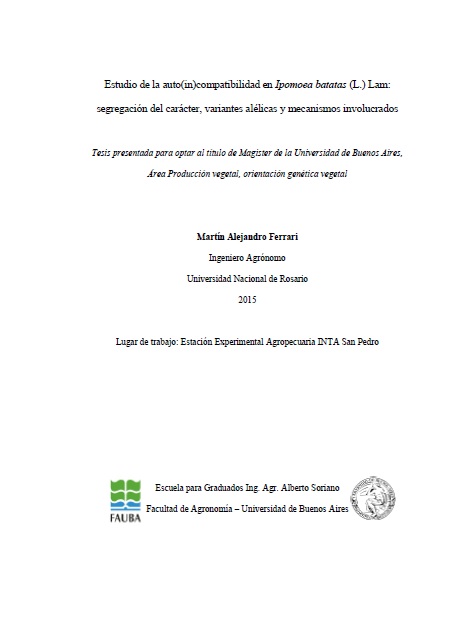Ver ítem
- xmlui.general.dspace_homeCentros Regionales y EEAsCentro Regional Buenos Aires NorteEEA San PedroTesisxmlui.ArtifactBrowser.ItemViewer.trail
Estudio de la auto(in)compatibilidad en Ipomoea batatas (L.) Lam: segregación del carácter, variantes alélicas y mecanismos involucrados
Resumen
La autoincompatibilidad es un mecanismo presente en las angiospermas basado en la capacidad del pistilo para identificar e inhibir la germinación o el desarrollo posterior de polen propio o relacionado genéticamente. El sistema de incompatibilidad esporofítico está controlado por un locus multigénico (locus S) que es heredado generalmente como una unidad segregante denominado “haplotipo S” permitiendo preservar el sistema de autoincompatibilidad. Ipomoea
[ver mas...]
La autoincompatibilidad es un mecanismo presente en las angiospermas basado en la capacidad del pistilo para identificar e inhibir la germinación o el desarrollo posterior de polen propio o relacionado genéticamente. El sistema de incompatibilidad esporofítico está controlado por un locus multigénico (locus S) que es heredado generalmente como una unidad segregante denominado “haplotipo S” permitiendo preservar el sistema de autoincompatibilidad. Ipomoea batatas (L.) Lam es una especie autohexaploide, con 90 cromosomas, autoincompatible, altamente heterocigota y que presenta segregación principalmente hexasómica. Además, la especie presenta incompatibilidad cruzada dificultando aún más el mejoramiento genético de la especie. El objetivo de la tesis fue estudiar la segregación del carácter autoincompatibilidad en I. batatas, su ruptura y las relaciones de dominancia existentes entre haplotipos. Se generaron dos progenies, una de ellas segregante para el carácter autoincompatibilidad y la otra a partir del autocruzamiento de un genotipo autocompatible. Se realizaron autocruzamientos en las progenies a fin de evaluar el carácter autocompatibilidad y retrocruzas recíprocas para evaluar las relaciones de dominancia. Además se evaluó la fertilidad masculina, femenina y el crecimiento del tubo polínico a través del gineceo. La presencia del carácter autocompatibilidad se observó en ambas progenies, comportándose como un carácter recesivo. Se encontraron diferentes comportamientos de compatibilidad en las retrocruzas recíprocas (incompatibilidad total, compatibilidad total, compatibilidad en un solo sentido). La progenie endocriada presentó disminución en la expresión de los caracteres vegetativos y reproductivos. Respecto a la fertilidad masculina, se observaron diferencias (p<0,05) entre los genotipos parentales y ambas progenies. El parental autocompatible fue siempre más fértil que el autoincompatible, y la progenie segregante más fértil que la endocriada. Respecto a la fertilidad femenina, no se encontraron diferencias significativas (p>0,05) entre ambas progenies. A partir de la evaluación del crecimiento del tubo polínico se detectaron genotipos autocompatibles. Se plantearon dos modelos que podrían explicar la ruptura de la autoincompatibilidad.
[Cerrar]
Self-incompatibility is a mechanism present in angiosperms based on the ability of the pistil to identify and inhibit germination or further development of self or genetically related pollen. The sporophytic incompatibility system is controlled by a multigene locus (S locus) that is generally inherited as a segregating unit called the "S haplotype" allowing the self-incompatibility system to be preserved. Ipomoea batatas (L.) Lam is an autohexaploid
[ver mas...]
Self-incompatibility is a mechanism present in angiosperms based on the ability of the pistil to identify and inhibit germination or further development of self or genetically related pollen. The sporophytic incompatibility system is controlled by a multigene locus (S locus) that is generally inherited as a segregating unit called the "S haplotype" allowing the self-incompatibility system to be preserved. Ipomoea batatas (L.) Lam is an autohexaploid species, with 90 chromosomes, self-incompatible, highly heterozygous and presenting mainly hexasomic segregation. In addition, the species is cross incompatible, making genetic improvement of the species even more difficult. The objective of the thesis was to study the segregation of the trait self incompatibility in I. batatas, its breakage and the dominance relationships between haplotypes. Two populations were generated, one of them segregating for the self incompatibility trait and the other from the self-crossing of a self-incompatible genotype. The progenies were self-crossed to evaluate the self-incompatibility trait and reciprocal backcrosses were performed to evaluate dominance relationships. In addition, male and female fertility and pollen tube growth through the gynoecium were evaluated. The presence of the self-compatibility trait was observed in both progenies, behaving as a recessive trait. Different compatibility behaviors were found in reciprocal backcrosses (total incompatibility, total compatibility, one-way compatibility). The inbred population showed a decrease in the expression of vegetative and reproductive traits. Regarding male fertility, differences (p<0.5) were observed between the parental genotypes and both populations. The self-compatible parental was always more fertile than the self-incompatible, and the segregating progeny more fertile than the inbred. Regarding female fertility, no significant differences (p>0.05) were found between both progenies. From the evaluation of pollen tube growth, self-compatible genotypes were detected. Two models were proposed that could explain the breakdown of self incompatibility.
[Cerrar]

Director de Tesis
Galati, Beatríz Gloria (co-directora);
Descripción
Tesis presentada para optar al título de Magister Scientiae, Área Producción vegetal, orientación genética vegetal, de la Universidad de Buenos Aires, en octubre de 2023.
Fecha
2023-10
Editorial
Facultad de Agronomía, Universidad de Buenos Aires
Formato
pdf
Tipo de documento
tesis de maestría
Palabras Claves
Derechos de acceso
Abierto
 Excepto donde se diga explicitamente, este item se publica bajo la siguiente descripción: Creative Commons Attribution-NonCommercial-ShareAlike 2.5 Unported (CC BY-NC-SA 2.5)
Excepto donde se diga explicitamente, este item se publica bajo la siguiente descripción: Creative Commons Attribution-NonCommercial-ShareAlike 2.5 Unported (CC BY-NC-SA 2.5)


